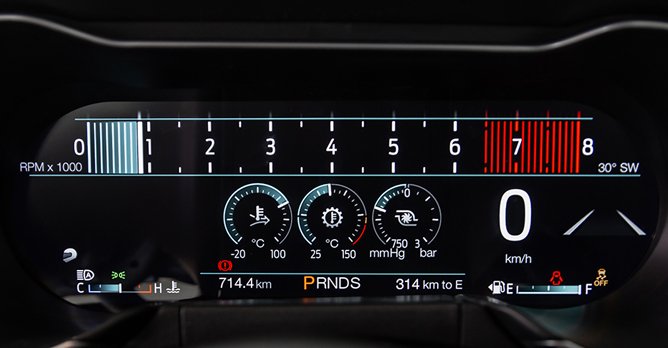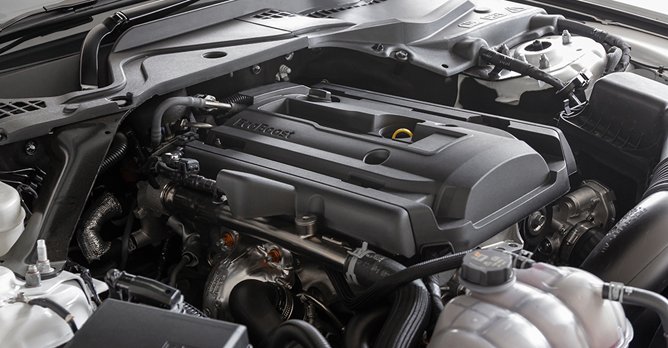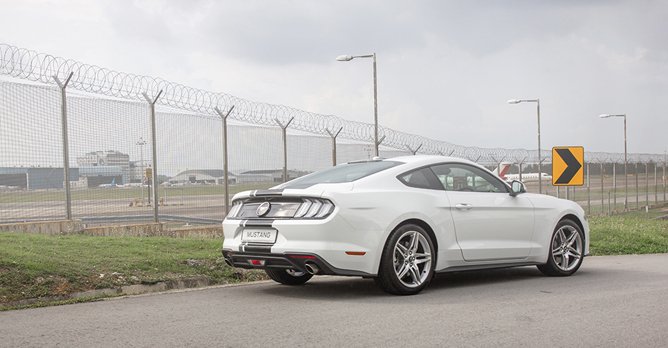Ford Mustang 2.3 EcoBoost (A) Facelift Review
30 Apr 2019|15,121 views
Facelift (What's New)
2.3-litre four-cylinder EcoBoost engine makes more torque, now pushing out 306bhp and 447Nm
LED head lights
Recaro semi-bucket seats
New 12-inch digital instrument cluster
There is nothing quite like the Ford Mustang - the quintessential muscle car. It's a common spot in the U.S. of A, but here, it's probably rarer than your average supercar.
And like a supercar, it turns heads.
Big changes inside
For this facelift, changes on its sheet metal are minor, with the most obvious being the addition of full LED head lights up front.
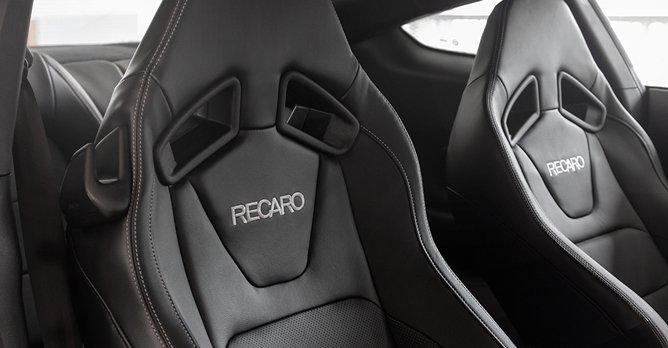
 The Recaro semi-bucket seats are a nice addition to the facelifted Mustang, and offer lots of support
The Recaro semi-bucket seats are a nice addition to the facelifted Mustang, and offer lots of support
The bigger visual changes are on the inside. Open the door, and you are greeted with the Recaro inscription on the two semi-bucket seats. They offer a low seating position, and are incredibly supportive - useful when you're pushing the car hard around bends.
There is also a new 12-inch digital instrument cluster, which allows some level of customisation, with different gauges and colours to choose from.
The Mustang's serious, sporty character is shown here. Digital gauges can be customised to display turbo boost readings, and even intake air temperatures and air/fuel ratios.
Interestingly, all of the car's settings - from drive modes to ambient lighting settings - are controlled from the instrument cluster. This leaves the 8.0-inch Ford Sync 3 infotainment system free to handle entertainment duties only.
Is there muscle?
Speaking of entertainment duties, yes, this Mustang may not come with an all-mighty American V8, but the 2.3-litre Ecoboost powerhouse is no slouch.
It pumps out 306bhp and 447Nm of earth-moving torque, mated to a new 10-speed transmission. Numbers-wise, it makes 15Nm of torque more, but 6bhp less than its predecessor.
Wait, how can this be?!
Hold your horses. It may make less power, but we believe the car was tuned to be more efficiently married to the new transmission.
With it, the new gearbox does a very good job in normal driving situations, but 10 forward ratios might be a lot to overcome. Hence, the gearbox skips gears when upshifting, making it drive just like a normal, smooth automatic transmission with five or six cogs.
And like a supercar, it turns heads.
Big changes inside
For this facelift, changes on its sheet metal are minor, with the most obvious being the addition of full LED head lights up front.

The bigger visual changes are on the inside. Open the door, and you are greeted with the Recaro inscription on the two semi-bucket seats. They offer a low seating position, and are incredibly supportive - useful when you're pushing the car hard around bends.
There is also a new 12-inch digital instrument cluster, which allows some level of customisation, with different gauges and colours to choose from.
The Mustang's serious, sporty character is shown here. Digital gauges can be customised to display turbo boost readings, and even intake air temperatures and air/fuel ratios.
Interestingly, all of the car's settings - from drive modes to ambient lighting settings - are controlled from the instrument cluster. This leaves the 8.0-inch Ford Sync 3 infotainment system free to handle entertainment duties only.
Is there muscle?
Speaking of entertainment duties, yes, this Mustang may not come with an all-mighty American V8, but the 2.3-litre Ecoboost powerhouse is no slouch.
It pumps out 306bhp and 447Nm of earth-moving torque, mated to a new 10-speed transmission. Numbers-wise, it makes 15Nm of torque more, but 6bhp less than its predecessor.
Wait, how can this be?!
Hold your horses. It may make less power, but we believe the car was tuned to be more efficiently married to the new transmission.
With it, the new gearbox does a very good job in normal driving situations, but 10 forward ratios might be a lot to overcome. Hence, the gearbox skips gears when upshifting, making it drive just like a normal, smooth automatic transmission with five or six cogs.
So how's it like to drive?
It may lack the aural meat of a big V8 engine, but the Ecoboost lump makes a nice, raspy noise which is unlike any four-cylinder engine we've heard. Mash the throttle and the Mustang will do the century sprint in a respectable 5.5 seconds.
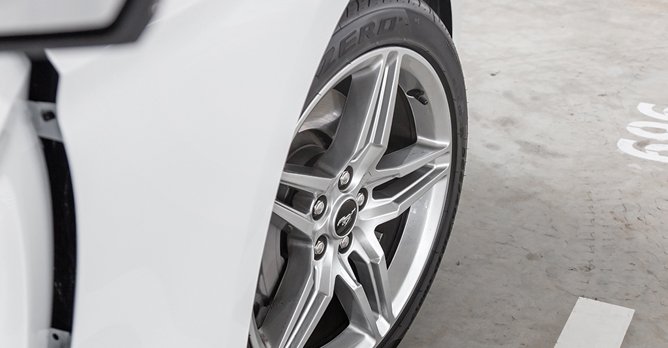
 The Mustang is equipped with grippy 19-inch Pirelli P Zero tyres as standard, aiding in the car's corner carving abilities
The Mustang is equipped with grippy 19-inch Pirelli P Zero tyres as standard, aiding in the car's corner carving abilities
Thus, there's no denying the car's power on the straights, but there's also no disapproving of the pony's love for bends, too. Thanks to a new cross-axis joint in the rear suspension, lateral stiffness has been increased, making for lesser body roll and tighter setup when carving corners.
And it's also through corners that the transmission does a good job in choosing and holding gears on its own, making sure that it's in the powerband when you're accelerating out of one.
And when you're done messing about, put it back to Normal drive mode and the Mustang settles down to be a comfortable cruiser.
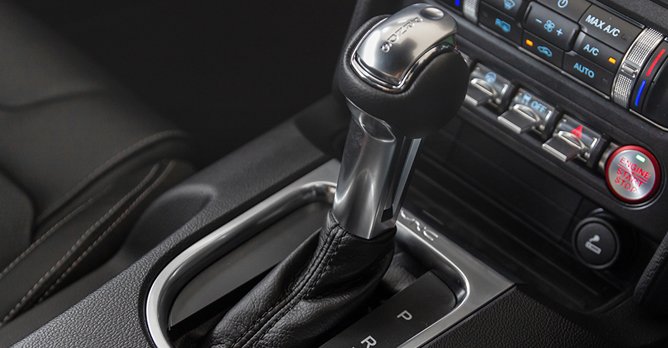
 The 10-speed automatic transmission does a good job in selecting the right gears without the driver's inputs
The 10-speed automatic transmission does a good job in selecting the right gears without the driver's inputs
It's no one-trick pony
The Ford Mustang is no one-trick pony. Not only is it fast, it's highly capable around bends, which is something of a feat considering muscle cars are mostly good for straight-line acceleration and obnoxious-sounding exhaust notes. In that sense, the Mustang breaks this muscle car stereotype.
Plus, the car is one good-looking machine. While its esteemed European competitors such as the BMW 4 Series Coupe and Audi A5 Coupe may be more polished and established, the Mustang beats them hands down in the looks department.
And with the double takes we got from kids and aunties during our three-day test drive, the Mustang is a clear winner.
It may lack the aural meat of a big V8 engine, but the Ecoboost lump makes a nice, raspy noise which is unlike any four-cylinder engine we've heard. Mash the throttle and the Mustang will do the century sprint in a respectable 5.5 seconds.

Thus, there's no denying the car's power on the straights, but there's also no disapproving of the pony's love for bends, too. Thanks to a new cross-axis joint in the rear suspension, lateral stiffness has been increased, making for lesser body roll and tighter setup when carving corners.
And it's also through corners that the transmission does a good job in choosing and holding gears on its own, making sure that it's in the powerband when you're accelerating out of one.
And when you're done messing about, put it back to Normal drive mode and the Mustang settles down to be a comfortable cruiser.

It's no one-trick pony
The Ford Mustang is no one-trick pony. Not only is it fast, it's highly capable around bends, which is something of a feat considering muscle cars are mostly good for straight-line acceleration and obnoxious-sounding exhaust notes. In that sense, the Mustang breaks this muscle car stereotype.
Plus, the car is one good-looking machine. While its esteemed European competitors such as the BMW 4 Series Coupe and Audi A5 Coupe may be more polished and established, the Mustang beats them hands down in the looks department.
And with the double takes we got from kids and aunties during our three-day test drive, the Mustang is a clear winner.
Facelift (What's New)
2.3-litre four-cylinder EcoBoost engine makes more torque, now pushing out 306bhp and 447Nm
LED head lights
Recaro semi-bucket seats
New 12-inch digital instrument cluster
There is nothing quite like the Ford Mustang - the quintessential muscle car. It's a common spot in the U.S. of A, but here, it's probably rarer than your average supercar.
And like a supercar, it turns heads.
Big changes inside
For this facelift, changes on its sheet metal are minor, with the most obvious being the addition of full LED head lights up front.

 The Recaro semi-bucket seats are a nice addition to the facelifted Mustang, and offer lots of supportThe bigger visual changes are on the inside. Open the door, and you are greeted with the Recaro inscription on the two semi-bucket seats. They offer a low seating position, and are incredibly supportive - useful when you're pushing the car hard around bends.
The Recaro semi-bucket seats are a nice addition to the facelifted Mustang, and offer lots of supportThe bigger visual changes are on the inside. Open the door, and you are greeted with the Recaro inscription on the two semi-bucket seats. They offer a low seating position, and are incredibly supportive - useful when you're pushing the car hard around bends.
There is also a new 12-inch digital instrument cluster, which allows some level of customisation, with different gauges and colours to choose from.
The Mustang's serious, sporty character is shown here. Digital gauges can be customised to display turbo boost readings, and even intake air temperatures and air/fuel ratios.
Interestingly, all of the car's settings - from drive modes to ambient lighting settings - are controlled from the instrument cluster. This leaves the 8.0-inch Ford Sync 3 infotainment system free to handle entertainment duties only.
Is there muscle?
Speaking of entertainment duties, yes, this Mustang may not come with an all-mighty American V8, but the 2.3-litre Ecoboost powerhouse is no slouch.
It pumps out 306bhp and 447Nm of earth-moving torque, mated to a new 10-speed transmission. Numbers-wise, it makes 15Nm of torque more, but 6bhp less than its predecessor.
Wait, how can this be?!
Hold your horses. It may make less power, but we believe the car was tuned to be more efficiently married to the new transmission.
With it, the new gearbox does a very good job in normal driving situations, but 10 forward ratios might be a lot to overcome. Hence, the gearbox skips gears when upshifting, making it drive just like a normal, smooth automatic transmission with five or six cogs.
And like a supercar, it turns heads.
Big changes inside
For this facelift, changes on its sheet metal are minor, with the most obvious being the addition of full LED head lights up front.

There is also a new 12-inch digital instrument cluster, which allows some level of customisation, with different gauges and colours to choose from.
The Mustang's serious, sporty character is shown here. Digital gauges can be customised to display turbo boost readings, and even intake air temperatures and air/fuel ratios.
Interestingly, all of the car's settings - from drive modes to ambient lighting settings - are controlled from the instrument cluster. This leaves the 8.0-inch Ford Sync 3 infotainment system free to handle entertainment duties only.
Is there muscle?
Speaking of entertainment duties, yes, this Mustang may not come with an all-mighty American V8, but the 2.3-litre Ecoboost powerhouse is no slouch.
It pumps out 306bhp and 447Nm of earth-moving torque, mated to a new 10-speed transmission. Numbers-wise, it makes 15Nm of torque more, but 6bhp less than its predecessor.
Wait, how can this be?!
Hold your horses. It may make less power, but we believe the car was tuned to be more efficiently married to the new transmission.
With it, the new gearbox does a very good job in normal driving situations, but 10 forward ratios might be a lot to overcome. Hence, the gearbox skips gears when upshifting, making it drive just like a normal, smooth automatic transmission with five or six cogs.
So how's it like to drive?
It may lack the aural meat of a big V8 engine, but the Ecoboost lump makes a nice, raspy noise which is unlike any four-cylinder engine we've heard. Mash the throttle and the Mustang will do the century sprint in a respectable 5.5 seconds.

 The Mustang is equipped with grippy 19-inch Pirelli P Zero tyres as standard, aiding in the car's corner carving abilitiesThus, there's no denying the car's power on the straights, but there's also no disapproving of the pony's love for bends, too. Thanks to a new cross-axis joint in the rear suspension, lateral stiffness has been increased, making for lesser body roll and tighter setup when carving corners.
The Mustang is equipped with grippy 19-inch Pirelli P Zero tyres as standard, aiding in the car's corner carving abilitiesThus, there's no denying the car's power on the straights, but there's also no disapproving of the pony's love for bends, too. Thanks to a new cross-axis joint in the rear suspension, lateral stiffness has been increased, making for lesser body roll and tighter setup when carving corners.
And it's also through corners that the transmission does a good job in choosing and holding gears on its own, making sure that it's in the powerband when you're accelerating out of one.
And when you're done messing about, put it back to Normal drive mode and the Mustang settles down to be a comfortable cruiser.

 The 10-speed automatic transmission does a good job in selecting the right gears without the driver's inputs
The 10-speed automatic transmission does a good job in selecting the right gears without the driver's inputs
It's no one-trick pony
The Ford Mustang is no one-trick pony. Not only is it fast, it's highly capable around bends, which is something of a feat considering muscle cars are mostly good for straight-line acceleration and obnoxious-sounding exhaust notes. In that sense, the Mustang breaks this muscle car stereotype.
Plus, the car is one good-looking machine. While its esteemed European competitors such as the BMW 4 Series Coupe and Audi A5 Coupe may be more polished and established, the Mustang beats them hands down in the looks department.
And with the double takes we got from kids and aunties during our three-day test drive, the Mustang is a clear winner.
It may lack the aural meat of a big V8 engine, but the Ecoboost lump makes a nice, raspy noise which is unlike any four-cylinder engine we've heard. Mash the throttle and the Mustang will do the century sprint in a respectable 5.5 seconds.

And it's also through corners that the transmission does a good job in choosing and holding gears on its own, making sure that it's in the powerband when you're accelerating out of one.
And when you're done messing about, put it back to Normal drive mode and the Mustang settles down to be a comfortable cruiser.

It's no one-trick pony
The Ford Mustang is no one-trick pony. Not only is it fast, it's highly capable around bends, which is something of a feat considering muscle cars are mostly good for straight-line acceleration and obnoxious-sounding exhaust notes. In that sense, the Mustang breaks this muscle car stereotype.
Plus, the car is one good-looking machine. While its esteemed European competitors such as the BMW 4 Series Coupe and Audi A5 Coupe may be more polished and established, the Mustang beats them hands down in the looks department.
And with the double takes we got from kids and aunties during our three-day test drive, the Mustang is a clear winner.
Car Information
Ford Mustang 2.3 EcoBoost (A)
CAT B|Petrol|10km/L
Horsepower
228kW (306 bhp)
Torque
447 Nm
Acceleration
5.5sec (0-100km /hr)
This model is no longer being sold by local distributor
All Used Ford MustangThank You For Your Subscription.
































